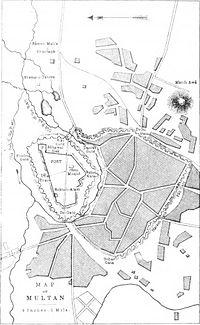Background Of Multan:
After he was defeated at the Battle of Attock, the Durrani Vizier, Wazir Fateh Khan, fought off an attempt by Ali Shah, the ruler of Persia, to capture the Durrani province of Herat. He was joined by his brother, Dost Mohammad Khan. Once they had captured the city, Fateh Khan attempted to remove the ruler, a relation of his superior, Mahmud Shah, and rule in his stead. In the attempt to take the city from its Durrani ruler, Dost Mohammad Khan's men robbed a princess of her jewels. Kamran Durrani, Mahmud Shah's son, used this as a pretext to remove Fateh Khan from power, and had him horribly tortured and executed.
The Sikh Empire had attacked Multan multiple times in the past, the largest attack being in 1810. However, on the previous occasions the Sikh forces would defeat the defending force and seize the city only to have the governor of Multan, Muzaffar Khan Sadozai, retreat into the Multan Fort. During previous sieges, the Sikhs had settled for large single payments of tribute, while the attack in 1810, resulted in Multan paying a yearly tribute. Muzaffar Khan already ruled the Durrani province of Multan independently of the descendants of Ahmad Shah Abdali, the rulers of Kabul. With the relatives of the deceased Fateh Khan engulfed in a power struggle with Mahmud Shah, no Durrani force would be able to relieve him.
While in power, however, Fateh Khan had installed twenty-one of his brothers in positions of power throughout the Durrani Empire. After his death the next eldest brother Mohd. Azim Khan, governor of Kashmir, led the Barakzais as they rebelled and divided up the provinces of the empire between themselves. During this turbulent period Kabul had many temporary rulers until Dost Mohammad Khan captured the city in 1826.
After he was defeated at the Battle of Attock, the Durrani Vizier, Wazir Fateh Khan, fought off an attempt by Ali Shah, the ruler of Persia, to capture the Durrani province of Herat. He was joined by his brother, Dost Mohammad Khan. Once they had captured the city, Fateh Khan attempted to remove the ruler, a relation of his superior, Mahmud Shah, and rule in his stead. In the attempt to take the city from its Durrani ruler, Dost Mohammad Khan's men robbed a princess of her jewels. Kamran Durrani, Mahmud Shah's son, used this as a pretext to remove Fateh Khan from power, and had him horribly tortured and executed.
The Sikh Empire had attacked Multan multiple times in the past, the largest attack being in 1810. However, on the previous occasions the Sikh forces would defeat the defending force and seize the city only to have the governor of Multan, Muzaffar Khan Sadozai, retreat into the Multan Fort. During previous sieges, the Sikhs had settled for large single payments of tribute, while the attack in 1810, resulted in Multan paying a yearly tribute. Muzaffar Khan already ruled the Durrani province of Multan independently of the descendants of Ahmad Shah Abdali, the rulers of Kabul. With the relatives of the deceased Fateh Khan engulfed in a power struggle with Mahmud Shah, no Durrani force would be able to relieve him.
While in power, however, Fateh Khan had installed twenty-one of his brothers in positions of power throughout the Durrani Empire. After his death the next eldest brother Mohd. Azim Khan, governor of Kashmir, led the Barakzais as they rebelled and divided up the provinces of the empire between themselves. During this turbulent period Kabul had many temporary rulers until Dost Mohammad Khan captured the city in 1826.
Background Of Multan:
After he was defeated at the Battle of Attock, the Durrani Vizier, Wazir Fateh Khan, fought off an attempt by Ali Shah, the ruler of Persia, to capture the Durrani province of Herat. He was joined by his brother, Dost Mohammad Khan. Once they had captured the city, Fateh Khan attempted to remove the ruler, a relation of his superior, Mahmud Shah, and rule in his stead. In the attempt to take the city from its Durrani ruler, Dost Mohammad Khan's men robbed a princess of her jewels. Kamran Durrani, Mahmud Shah's son, used this as a pretext to remove Fateh Khan from power, and had him horribly tortured and executed.
The Sikh Empire had attacked Multan multiple times in the past, the largest attack being in 1810. However, on the previous occasions the Sikh forces would defeat the defending force and seize the city only to have the governor of Multan, Muzaffar Khan Sadozai, retreat into the Multan Fort. During previous sieges, the Sikhs had settled for large single payments of tribute, while the attack in 1810, resulted in Multan paying a yearly tribute. Muzaffar Khan already ruled the Durrani province of Multan independently of the descendants of Ahmad Shah Abdali, the rulers of Kabul. With the relatives of the deceased Fateh Khan engulfed in a power struggle with Mahmud Shah, no Durrani force would be able to relieve him.
While in power, however, Fateh Khan had installed twenty-one of his brothers in positions of power throughout the Durrani Empire. After his death the next eldest brother Mohd. Azim Khan, governor of Kashmir, led the Barakzais as they rebelled and divided up the provinces of the empire between themselves. During this turbulent period Kabul had many temporary rulers until Dost Mohammad Khan captured the city in 1826.
0 Commentarii
0 Distribuiri
0 previzualizare




